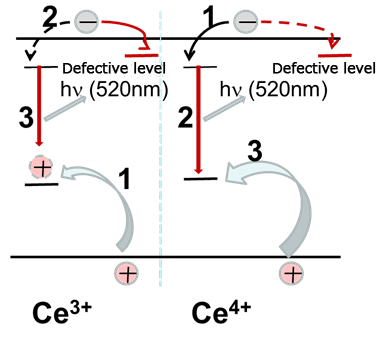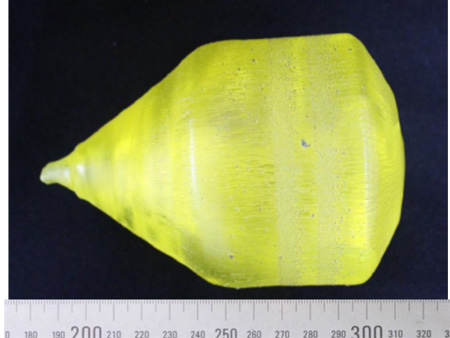The 16th (2016) Yamazaki-Teiichi Prize Winner Material
Developments of a novel garnet scintillators and industrialization by the academic startups
| Winner | ||
|---|---|---|
| Akira Yoshikawa | ||
| History | ||
| Jun. 1997 | Research Associate, Institute for Materials Research, Tohoku University | |
| Oct. 2003 | Associate Professor, Institute of Multidisciplinary Research for Advanced Materials, Tohoku University | |
| Oct. 2007 | Visiting Professor, University of Milano-Bicocca, Italy | |
| Dec. 2008 | Visiting Professor, Claude Bernard University Lyon 1, France | |
| Apr. 2011 | Professor, Institute for Materials Research, Tohoku University Professor, New Industry Creation Hatchery Center, Tohoku University (Present) |
|
| Nov. 2012 | CEO and Representative Director, C&A Corporation (Present) | |
| Winner | ||
|---|---|---|
| Kei Kamada | ||
| History | ||
| Apr. 2005 | Researcher, General Material Research Institute, Furukawa Co., Ltd. | |
| Mar. 2006 | Completed Doctorial Program, Material Processing Process, School of Engineering, Tohoku University | |
| Nov. 2012 | President and Representative Director, C&A Corporation (Present) | |
| Apr. 2013 | Associate professor, New Industry Creation Hatchery Center, Tohoku University (Present) | |
| Winner | ||
|---|---|---|
| Yasuhiro Shoji | ||
| History | ||
| Mar. 2000 | Graduated from Materials Engineering Course, Miyagi National College of Technology | |
| Apr. 2002 | Researcher, Fukuda Crystal Laboratory Corporation | |
| Apr. 2007 | Chief Researcher, Fukuda Crystal Laboratory Corporation | |
| Feb. 2010 | Manager of Technology Section, Smart Solar International Corporation | |
| Nov. 2012 | Senior General Manager, Single Crystal Business Department, C&A Corporation (Present) | |
Reason for award
Radiation detectors are composed of scintillators and photodetectors. Scintillators are widely employed in the fields of medical diagnostics, industry, agriculture, and science. Until recently, most of them were manufactured by overseas corporations with little room for domestic corporations to venture into production.
Prof. Akira Yoshikawa, Prof. Kei Kamada, and Mr. Yasuhiro Shoji developed a Ce-doped Gd3Al2Ga3O12(GAGG) scintillator in 2010, which had the best characteristics among contemporary scintillators, based on material design with the aid of bandgap control. The characteristics include a luminescence 1.5 times larger than that of the conventional material Tl:NaI, a three times shorter fluorescence lifetime, and a high-energy resolution that reaches 5% at 662 keV. After the material was developed, a business venture was launched, which resulted in the development of the technology to produce large Single Crystals with the facility of mass production, enabling recyclable and low-cost production, the technology to produce fine and high space resolution scintillator arrays using BaSO4, and other technologies expanding the scintillator business. All these have been contributing to the creation of a secure and safe society through the productization of compact radiation detectors, survey meters, food radiation detectors, gamma cameras, and other radiation detection equipment. Furthermore, with scintillators being manufactured in the country itself, the prospect of their integration with domestic photodetectors is motivating domestic corporations to develop indigenous radiation detectors, imaging devices for medical diagnostics, and much more. In addition to their application to imaging devices for medical diagnostics, they may also find applications in the field of high-energy physics, for example, as sensors in a synchrotron radiation facility.
Based on the above considerations, it has been determined that the aforementioned persons, viz. Prof. Yoshikawa, Prof. Kamada, and Mr. Shoji, should be the prizewinners of the 16th Yamazaki-Teiichi Prize in Materials.
Background of research and development
The global importance of radiation measurement has been increasing especially in recent years, in the fields of medical diagnostics, security, resource mapping, basic science, etc. There are a variety of fields in which scintillators are employed, including the study of high-energy physics, medicine, industry, and agriculture. The market size of scintillator crystals themselves is approaching one hundred billion yen, that of detectors is three hundred billion yen, and the total size is trillions of yen, including devices. In addition, in our country, they have played an important role in decontamination after the Fukushima Nuclear Accident. Radiation detection equipment comprises of a scintillator and a photodetector. Its characteristics depend on the scintillator. Therefore, highly efficient and highly sensitive scintillators are important. However, the current circumstances are so inflexible that "Europe and the US develop scintillators and hold their intellectual properties; their production is done in China. Japan imports them to integrate them with its domestic photoconductors for export. Europe and the US combine them with devices as per their own designs, and finally, Japan imports them." This has made little contribution to this country's economy. In order to overcome this inflexibility, the prizewinners were very determined to endeavor toward the development of new scintillators and, by using them, indigenously develop radiation detection equipment and associated devices in Japan.
Achievements
Yoshikawa and Kamada, from Tohoku University, used bandgap control to develop a Ce:Gd3Ga3Al2O12(GAGG) scintillator in 2010, which had the best characteristics, adhering to the principle of controlling scintillator characteristics through material design. They achieved further improvement in the GAGG characteristics by creating a singular energy level in the bandgap through the addition of Mg, Ca, and other trace elements. Utilizing the defect levels unique to garnet structures and the 4f4f level of Gd3+, they were able to reduce the long-life components and increase the luminescence from the transitions of the short-life component of Ce3+5d-4f. Thus, they succeeded in increasing the transition speed of the fluorescence lifetime to 40 ns or even lower, which was comparable to that of Ce:(Lu,Y)2SiO5 (LYSO) (Fig. 1).

Fig. 1 Co-doping with Mg2+ generates a singular energy level, which reduces the long-life component through the defect level and the 4f4f level of Gd3+. Consequently, the luminescence in the transition of the short-life component of Ce3+5d-4f is accelerated in this model.
For the practical application of GAGG, Yoshikawa and Kamada, along with Shoji established C&A Corporation―a business venture originating in the university―in November 2012, on the basis of the principle that the practical applications of university-developed materials should be expedited. Kamada took up the position of President as he had experience in creating business at a large corporation.

Fig. 2 A GAGG bulk monocrystal three inches in diameter
They established the Monocrystal Business Department at C&A Corporation, where, along with Shoji, Manager of the Business Department, at the center, they developed a technology to produce bulk crystals, which were two inches and three inches in diameter (Fig. 2). They transferred the technology and established an organization to produce scintillator crystals without a fabrication facility and by using the existing infrastructure of a local corporation. They also established a technology for the production of minuscule scintillator arrays with the best resolution in the world, and expanded their scintillator business, reporting unconsolidated sales of 350 million yen (by C&A Corporation). They expanded their sales to research institutes and corporations nationally as well as internationally, and used their academic-industrial alliance for the development of devices, making a contribution toward the supply of survey meters, food radiation detectors, gamma cameras, and other radiation detectors to cope with the nuclear accident. The market size in relation to GAGG is estimated to be 4 billion yen. They have contributed to the creation of a new market. To obtain certified approval for the devices, the standardization of GAGG as a scintillator for measuring natural radioactivity is being carried out in the country as well as overseas.
Meaning of the achievements
In the field of scintillators, the work of Dorenbos et al. is well-known, in which they defined S (energy transport efficiency) and Q (luminous efficiency), and statistically summarized which scintillator had higher light yield. However, this work just summarized some tendencies, and did not provide any specific guide regarding the design of ideal scintillators or scintillators with variable characteristics. Yoshikawa and Kamada, on the other hand, advanced their research with the design principle that "if we control the bandgap of host material and the energy level of dopant as to an optimal relative position, then a highly-efficient energy transition from the host material to the luminescence center is realized, thus facilitating the design of high-efficiency scintillators". Thus, they formed a model based on the fact that the level of the dopant (Ce) and the relative position of the valence band of the host crystal (Lu,Y,Gd)3(Ga,Al)5O12 had a strong relation with the light yield of the scintillators. They further advanced their work by proposing a model of the particular case in which co-doped Mg2+ generated a special energy level coming from Ce4+, reduced the slow component through the defect levels typical to the garnet structure and the 4f4f level of Gd3+, and accelerated the luminescence in the transition of the short-life component Ce3+5d-4f.
Besides proposing a model, they also created a new material for verification and established an academic start up company with Shoji, employing the technology for mass-production, succeeding in their business. This is a significant achievement. These accomplishments bring high expectations in the future as well.
